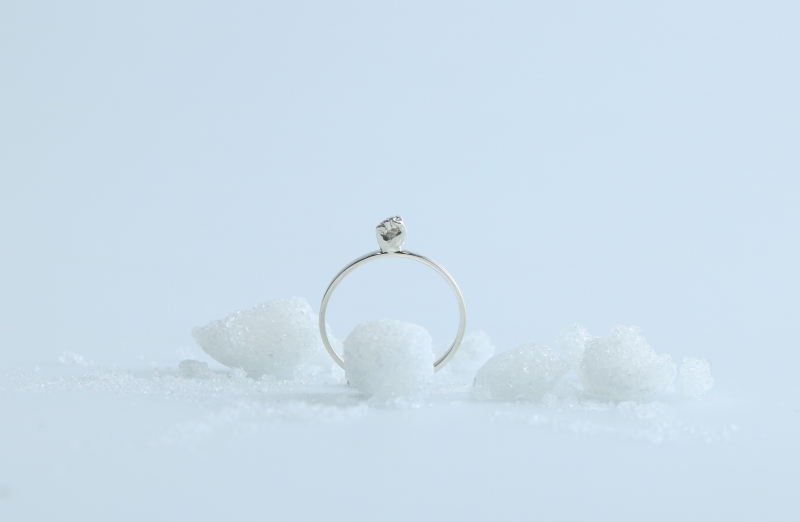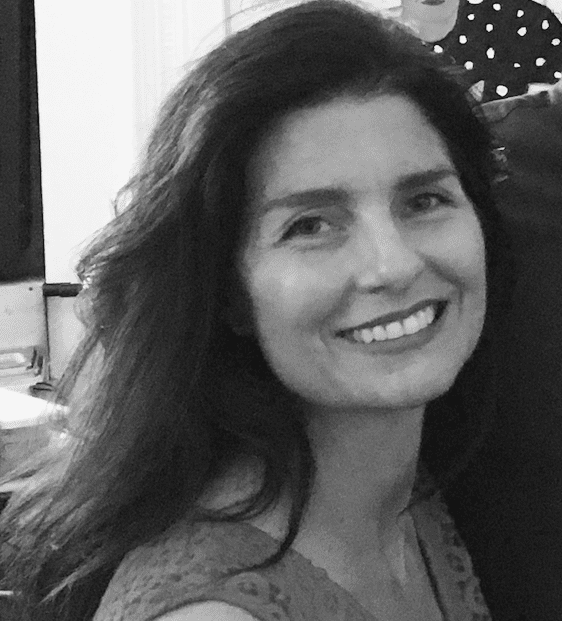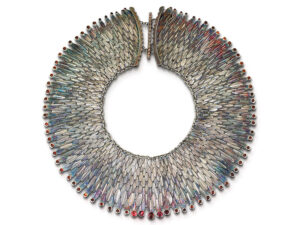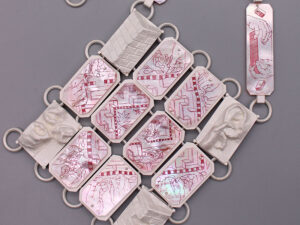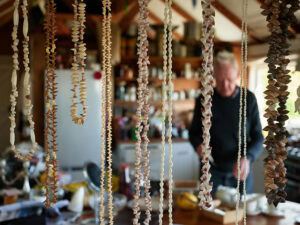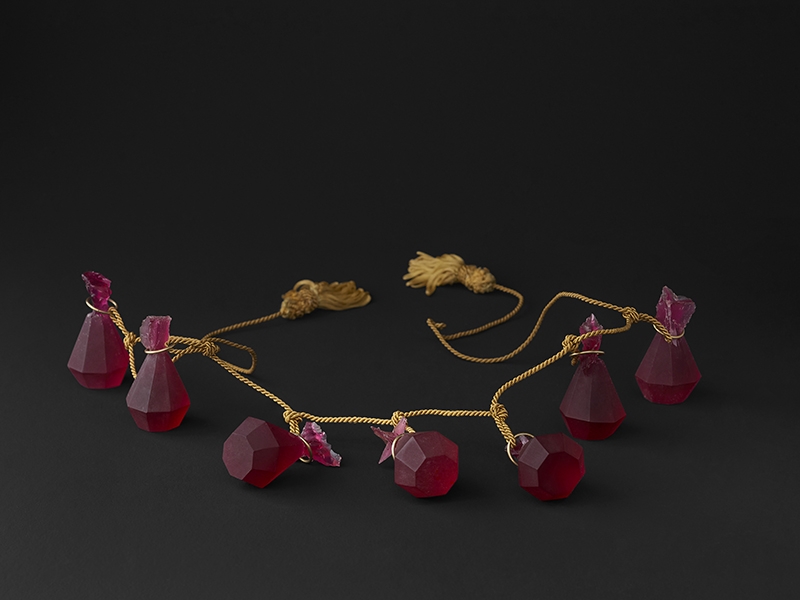
An important exhibition exploring the concept of power in jewelry just took place in Denmark. In honor of the 750th anniversary of castle Koldinghus, The Splendour of Power, curated by Anni Nørskov Mørch, curator and head of exhibitions at Museet på Koldinghus, featured the most prestigious jewels in Europe from the leading royal families, as well as contemporary pieces by artists well known to us today. I was honored to interview Nørskov Mørch regarding her experience with assembling this important show, curator to curator. Our conversation took place over email during October 2018, a few weeks before the exhibition closed.
Barbara Gifford: Tell us how your idea for this exhibition came about, how long ago you proposed it, how you decided which pieces would be in the show, and the process for getting those very exclusive loans. Did you have to guarantee certain casework, for example? What made the entities involved comfortable lending these very prestigious pieces to your institution?
Anni Nørskov Mørch: The idea for The Splendour of Power grew from the castle Koldinghus itself. We have of course known and for some time prepared for 2018 to be something out of the ordinary—being that it’s the castle’s 750-year anniversary. We wanted the anniversary exhibition to reflect upon the castle’s 750 years of history in the center and at the periphery of power using the distinguishing feature of the museum collection—craft, jewelry, and silver.
The pieces in The Splendour of Power were chosen to cover the history of power through the 750 years from 1268 to today as it has unfolded from the viewpoint of Koldinghus, which includes events and people from Denmark, Europe, and an increasing part of the world as Koldinghus and Denmark have become part of the globalized world of today.
Close cooperation with the Danish Royal Family and HM the Queen’s curator Elisabeth von Buchwald during the last three years, which resulted in exhibitions like Fabergé: The Tsar’s Jeweller and the Connections to the Danish Royal Family (2016) and Stone of Heaven: HRH Prince Henrik’s Collection of Oriental Jade Art (2017), built the foundation for the collaboration on The Splendour of Power.
Obviously, loans for an exhibition like this are built on trust and a very generous commitment from the owners of the exhibits—trust that relies on a strong exhibition concept, long-lasting relationships, and rigorous security.

To illustrate the relationship between power and jewelry, please talk about a piece in the exhibition that represents jewelry as power and also a piece that problematizes this relationship.
Anni Nørskov Mørch: A contemporary piece that displays political power and the communicative power of jewelry is the brooch Breaking the Glass Ceiling, lent to the exhibition by former Secretary of State Madeleine Albright and the US Diplomacy Center. The brooch was made by Vivian Shimoyama to promote the advancement of women. The brooch is made with clear iridescent glass and 14-karat gold trim and it shows, in the words of Secretary Albright, “the proverbial glass ceiling in its ideal condition: shattered.” Worn by one of the most powerful and thoughtful women in modern history, this brooch becomes a feminist exclamation point reminding us to keep pushing forward to make power equally accessible to all genders. The piece illustrates—in good company with the rest of Secretary Albright’s famous collection of brooches—how jewelry can be used as a diplomatic tool, to convey difficult messages in a clear but gentle way. Albright is using the power of jewelry and her status as Secretary of State to shatter the male hierarchical notion of power. She is using the power of jewelry in an expected way—as a form of communication of a new power structure.
A piece that represents power—that might be in need of problematizing—is the Rolex watch. It was lent to the exhibition by an anonymous owner. In this case, the lack of provenance attached to the individual piece only strengthened the point we were trying to make by including it in the exhibition. Today the opportunity for social mobility is very high in Denmark; however, our society’s power structures might not be as transparent as we’d like to think. In the Middle Ages—and I’m over-generalizing here—society was structured as a static hierarchy and social mobility was low. Power structures, however, were quite unequivocal and, when expressed in jewelry, completely out in the open. Today, the dark suit is the rarely challenged uniform of the powerful man. The Rolex Day Date is a classic luxury accessory, one of the few available accessories for men, and a natural part of the power uniform. However, this watch is deceiving in the sense that it’s easily mistaken for a watch made with a steel bracelet. The ice blue dial indicates for those in the know that this watch is in fact made of platinum, making it extremely expensive and a discrete sign of economic power.
Accessory designers from Designschool Kolding offer a contemporary or futuristic perspective on the relations between power and jewelry in pieces made especially for the exhibition The Splendour of Power. Their collections reflect on the questions of what jewelry will we need in the future to exercise power, to express power, to reflect upon power and problematize power? Sara Dalsager’s ring, with a raised fist coated in sugar, reminds us of the oppressive power structures of colonialism and of Denmark’s role in the triangular trade. Ninon Lê Van invites people to reflect on the possible consequences if we use our hands only to operate digital tools. One of those changes, according to some studies, is that the size of our thumbs could increase. Her accessory is literally a big thumb made of fragile porcelain, intended to show, in her own words, “the weakness of a world that becomes digitized, where we forget all the amazing things our hands can create.”
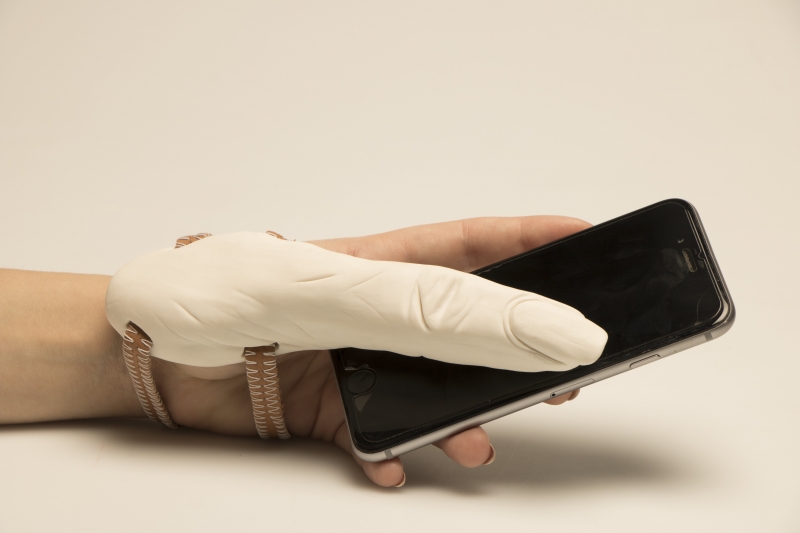
Please tell us about the exhibition design. How did it support the story you wanted to tell?
Anni Nørskov Mørch: We worked with a few distinct spatial concepts to make the exhibition design intuitive and emotionally moving and capable of drawing attention to the pieces themselves.
A path leads through the exhibition to convey that you have stepped into a chronological exhibition, a time travel, if you will. Lights are dimmed and focused on the pieces lifted by discrete fittings from the black, tightly upholstered velvet cushions that enhance the colors of the stones and give the most flexible underlay for mounting the many different pieces.
Every display case stretches to the ceiling as a pillar, with the upper half showing an image of the main character of the collection of jewelry in the individual case in order to create a dramatic and architectural effect and put a face to the pieces.
Five areas in the exhibition show films and give the audience the opportunity to dive deeper into select stories; golden chains hanging from the ceiling surround these areas. We needed a room divider that provided visibility for security reasons, and at the same time it was important for us not to add any materials that were unconnected to the intention of the exhibition—so golden chains were an obvious choice. Golden chains are an important type of jewelry in connection with power, but they’re not present as an exhibition piece. Golden chains from the Middle Ages and Renaissance are rare because they’ve simply been melted or used not only as symbols of power and prosperity but as ready cash, link by link. So these golden curtains were a way for us to hint at this particular type of power symbol.
After a lengthy search for the right type of chain, our exhibition designer, Margit Soome, bought 5.5 kilometers (!) of chain from an online retailer. And then we waited. And waited. Finally, all the boxes arrived and the chain inside turned out to be perfect. Only it had to be untangled and cut into the right lengths and then mounted. For two weeks, all hands were untangling the chains. Volunteers came in and spent days untangling alongside the event coordinator, the manager, the PhD. Everybody untangled. You wouldn’t believe how many silly jokes you can make about chains—the experience really brought us together.

This exhibition is in honor of the 750th anniversary of Koldinghus. How has Denmark’s power structure changed during this time, and, coinciding with this, the relationship it has with jewelry?
Anni Nørskov Mørch: Some examples might illustrate the changes in power structures and the use of jewelry.
The exhibition begins with the signet ring of the founder of the castle, Erik Klipping, and ends with HM the Queen’s Greenlandic tiara, thereby spanning from a king to the queen of a constitutional monarchy, and from a type of jewelry that could be used in a very concrete sense as a tool of power to a beautiful floral symbol of a close but complicated relationship between nations.
The graffiti pendant by the Detroit-based company Rebel Nell reinterprets the term power in its most acutely relevant form today as “empowerment.” The company sells jewelry but even more so the idea that education and decent pay can help the (female) employees of the company regain power over their own lives. This notion is celebrated in Denmark also. Denmark today is not about exerting power over its subjects but rather empowering its subjects to create respectable lives.
During the exhibition period, I’ve often worn my Dagmarcross to work at Koldinghus. I received this embossed silver pendant for my christening from my grandmother, as is still the custom in Denmark. It has served as a perfect opener for conversations about one of the pieces in the exhibition since many Danish—primarily—women, have a similar pendant.
The original cross is an exquisite Byzantine enamel cross from the early Middle Ages found in the grave of the Danish Queen Dagmar. In 1863, the small unearthed jewel became a national symbol of greatness—unrelated to size—when it was replicated in the wedding gift from the Danish king to future Queen Alexandra for her wedding to Edward, prince of Wales and future Edward VII. The 1863 replica was a refined piece of political communication, and an example of a new use of jewelry in the Danish royal family, which needed to rebrand itself as the ideal family and keeper of cultural heritage and national common denominator after the king renounced his absolute power and signed the Danish constitution in 1848.
Princess Alexandra brought with her from the tiny kingdom of Denmark to the great British empire the extraordinary replica of the Dagmarcross—complete with a splinter of the Holy Cross wrapped in a silk cloth from the grave of the Holy Canute, leader of Viking raids to England—hanging from an elaborate gold necklace with 118 pearls and 2,000 diamonds. The small kingdom of Denmark could not compete with the grandeur of most nations, but this little piece of jewelry documented another kind of greatness and the finest royal ancestry. Today the same logic applies to the notion of royal jewelry in Denmark, as expressed by the Danish queen in 2001: “In my family we don’t count the carats, we count the centuries.” History beats carats, and a well-executed piece of storytelling jewelry says more than a thousand diamonds. The necklace from 1863 is a very rare guest to Denmark since it’s now part of the British Royal Collection. Before The Splendour of Power, I believe it hadn’t been in Denmark since 1957, when it was used by HM Queen Elizabeth herself during her official state visit to Denmark.
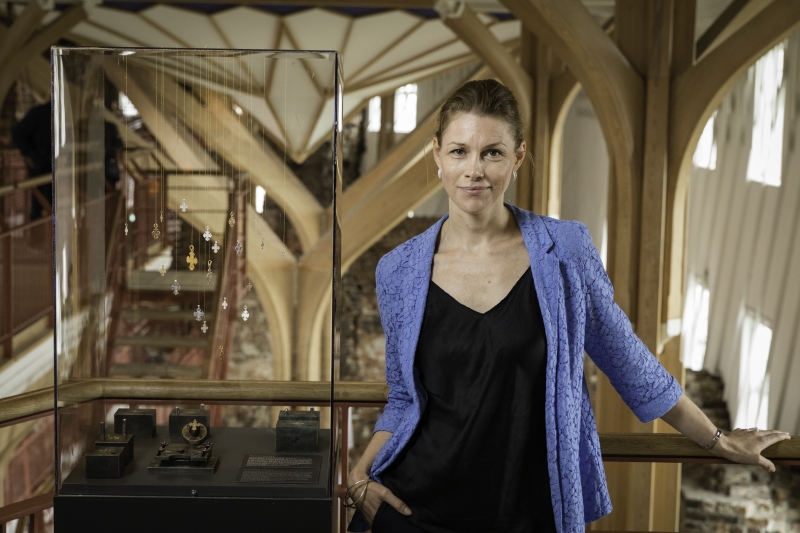
I like the observation mentioned in the exhibition description on the Koldinghus website that jewelry and architecture historically shared a certain communication about power. Is this still the case?
Anni Nørskov Mørch: At Museet på Koldinghus, being surrounded by the ruinous walls of the castle, we experience the communicative potential of architecture every day.
The castle that houses the museum was founded in 1268 by the Danish king as a wooden fortress manifesting the king’s sovereignty close to the border of that time. During the following centuries, the fortress was rebuilt many times by different kings to suit their needs for fortification, residence, dower, symbol of power, asylum from the plague, and banquet facility. In 1808 the castle was in a neglected and worn-down state, but still strategically well placed and therefore came into use as a temporary residence for Marshal Bernadotte, leader of Napoleon’s troops and an ally of Denmark in the Napoleonic Wars. The soldier’s stay made an unanticipated permanent mark on the castle, which burned down to a ruin on the night between March 29 and 30, 1808, partly due to freezing soldiers, partly due to the neglected state of the castle, and partly due to the local fire watch not returning to their posts after supper.
Today the museum employees say, half in earnest and half in jest, that the 1808 fire is the best thing that ever happened to the museum. The fire left the castle a ruin, stripped of its plaster, so every era’s refurbishment is now visible. Today you can stand in the courtyard and read the bricks of the castle as an open history book. The final restoration (1970s–1990) by the architects Inger and Johannes Exner has honored the history of the castle by leaving the ruin untouched, adding only the necessities: roof, stairs, decks, and supporting wooden pillars.
Two very different contemporary examples in the exhibition speak to the claim that jewelry still communicates about power.
Countess Sussie’s extraordinary golden lily of the valley bag hook is an example of a conversation piece used by a member of the royal family to both display exclusivity and genuinely help people feel more comfortable in, for example, the complicated social situation of a reception with royal attendance. I’ve seen the bag hook in action as such a conversation piece. The Countess is a very pleasant storyteller and, unlike royal jewelry of the past that could be said to aim to make people shut up, this piece does function as an icebreaker.
Laura Jack’s piece of art jewelry Does the Carpet Match the Drapes? works very differently by placing a mirror up to the deeply rooted expectations of how a (female) body might express itself in our emancipated society. Unshaved female armpits are a strong political statement today, and so is this piece of jewelry.
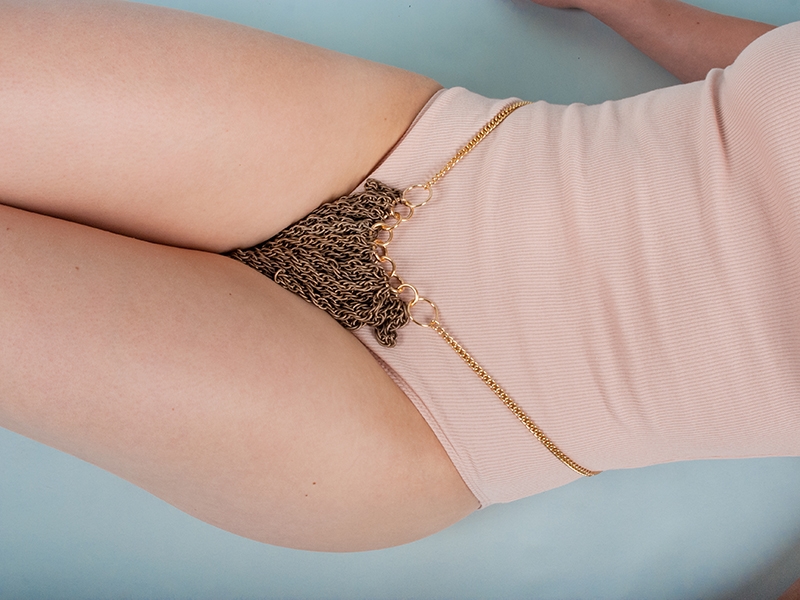
The exhibition closed October 21, 2018. What did you learn from it? Did your relationship with the exhibition evolve?
My relationship with this exhibition has evolved just like with any other exhibition—only amplified. After having moved through all the phases of ideation, concept development, fundraising, researching, writing, realization, and communication, in some sense the exhibition is in the past for the exhibition team the moment it opens for everyone else. Then the same thing always seems to happen: People interact with the exhibition, and suddenly you receive tons of feedback and new angles to the pieces you thought you knew so well. A direct descendant of a recipient of an order of chivalry given to only 12 men once in 1616 in the Great Hall at Koldinghus stands before you in the very same hall at the exhibition opening telling the goosebump-inducing story of their family (this actually happened). An eager visitor and priest get intrigued by one particular piece and go out of their way to find the theological reasons behind the use of a mousetrap as a motif in a Renaissance pendant from the Swedish Royal Collection. (This also happened—it turns out that the pendant refers to the “mousetrap” view of atonement in which Christ’s death and resurrection is seen as a trap set for Satan.) I find this learning experience very satisfying and terribly disturbing—today I wish I could write my contribution to the (3.5 kilo) catalog all over again so I could include all the new findings.
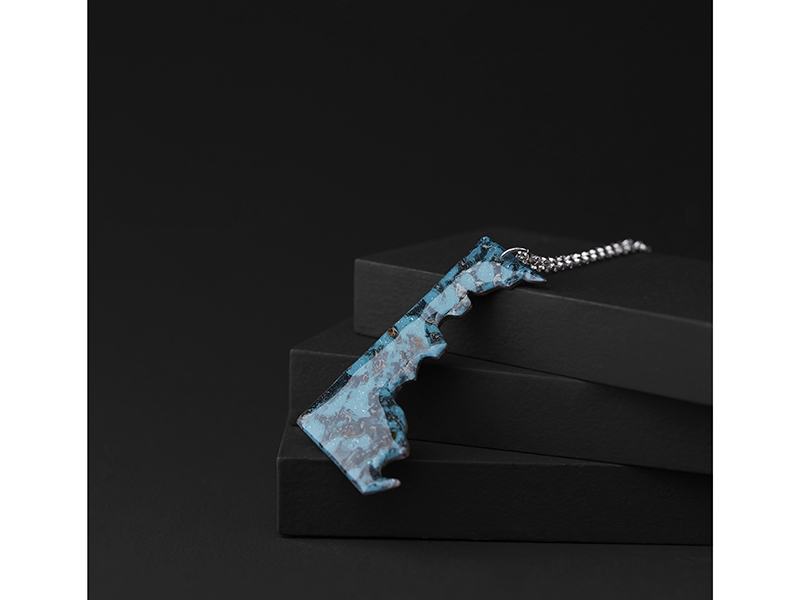
With the opportunity to work with and show jewelry from the Middle Ages to the present, what did you learn about jewelry that maybe you hadn’t realized before?
Anni Nørskov Mørch: I’ve become more aware of the fact that when working with jewelry, the empirical source material may have a bias toward the history of the privileged few. Displaying the splendor of power is easy. Today I wonder polemically if one could make a historical jewelry exhibition about anything other than power?
Pieces of jewelry are privileged objects also in the sense that pieces handed down through history have an exclusive character, as the powerful, the wealthy, the cultural elite, and prevailing notions of taste have secured or bolstered their place in history by means of jewelry, while “the others” are excluded. I wonder how one could tell the history of “the others” with jewelry? There are cracks in the exhibition that hint to this “back side of the medal,” but it’s something that would be interesting to explore further.
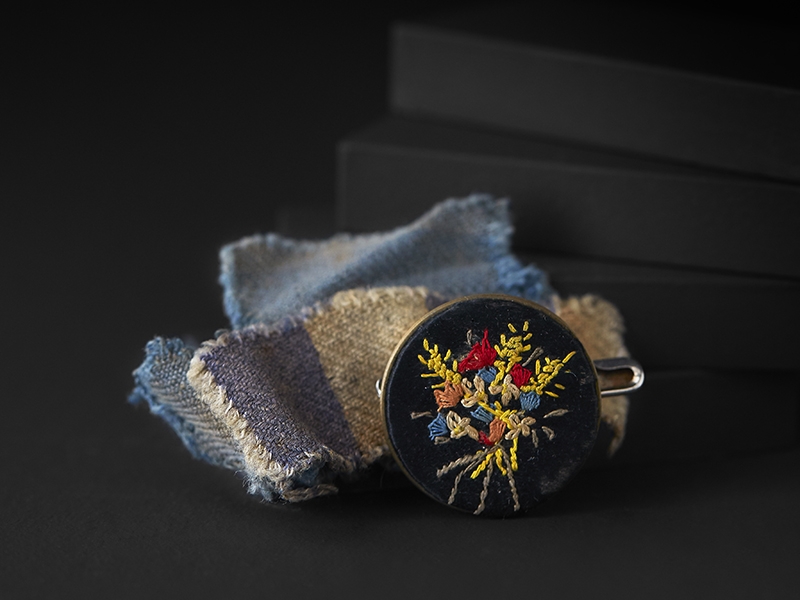
What do you think this exhibition meant to the people of Denmark?
Anni Nørskov Mørch: This is a very difficult question for me to answer, but I guess the number of visitors speaks to the interest of our Danish (and foreign) guests. We had approximately 105,000 visitors. Hopefully they found the exhibition relevant and thought-provoking. The exhibition received overwhelming reviews in Danish newspapers—six stars and hearts out of six possible in all six reviews—and that confirms to me that pieces of jewelry are potent carriers of both the grand history that we’re a part of, as individuals and as a community, and of our individual, personal history.
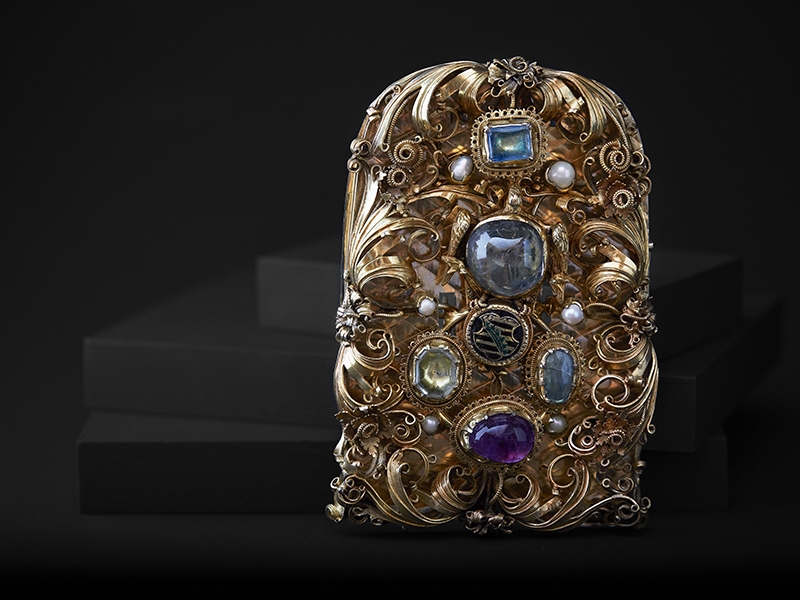
What will you work on next?
Anni Nørskov Mørch: Our exhibition program has a mix of large thematic exhibitions and smaller solo or group exhibitions of contemporary artists, silver- or goldsmiths. So currently I’m preparing the duo exhibition Different but Same, which will open December 1 with almost 100 pieces in silver by two of Denmark’s most acclaimed, productive, and individualistic silversmiths, the Danish-Japanese Yuki Ferdinandsen and the Dane Carsten From Andersen. They have refined each of their signature techniques, where the hammer decorates the surface of objects situated at the intersection of functional hollowware and sculptural artwork. They’re different but similar, and their craftsmanship is inspiring in this age of hectic production and consumption.
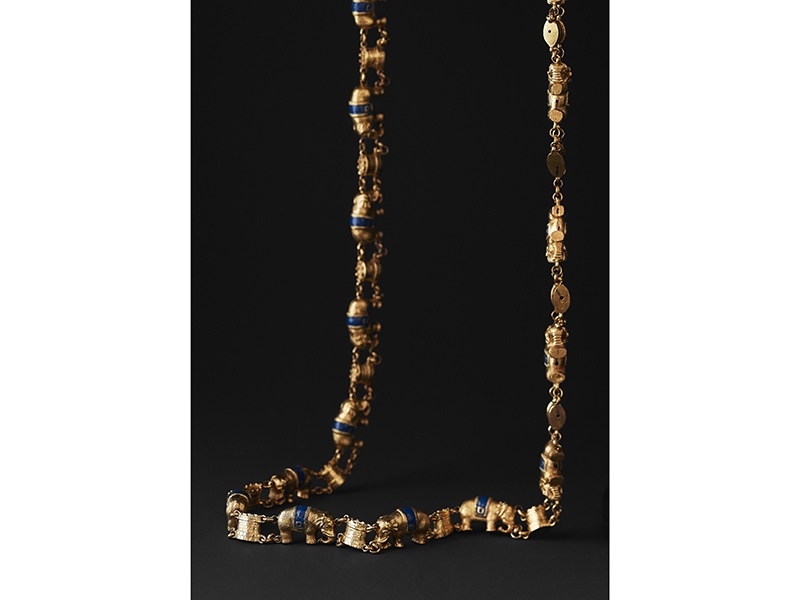
Have you seen, listened to, or read something that would be of interest to our audience? What books or movies are capturing your interest right now?
Anni Nørskov Mørch: That’s a wonderful question; the importance of a daily intake of art for no specific purpose, whether literature, movies, music, or any other genre, cannot be overstated. In honor of the hectic reality of my own and most people’s lives, I’d like to recommend a few podcasts that enrich my otherwise mind-numbing daily commute.
For some time my favorite podcasts have been “Still Processing,” by Wesley Morris and Jenna Wortham of the New York Times, and “The Longform Podcast,” hosted by Aaron Lammer, Max Linsky, and Evan Ratliff.
